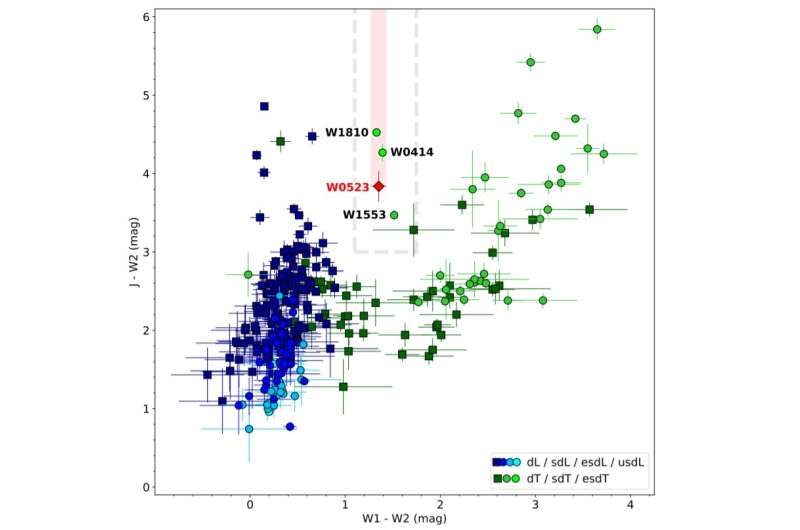August 2, 2021 report
WISEA J052305.94-015356.1 may be an extreme subdwarf of T-type

By analyzing the data from various surveys, a British amateur astronomer has found that a recently discovered star, designated WISEA J052305.94-015356.1, may be a representative of a rare class of subdwarfs—an extreme subdwarf of the T spectral class (esdT). The finding is reported in a paper published July 23 on arXiv.org.
Cool subdwarfs are metal-deficient stars and are among the oldest members of the galactic population. The most metal-poor objects of this type are known as extreme subdwarfs (ESD), and ultrasubdwarfs (USD), which have metallicities below values −1.0 and −1.5, respectively. To date, no ESD or USD of spectral class T have been identified, but one study published last year announced the detection of two ESDT candidates, namely WISEA J041451.67−585456.7 and WISEA J181006.18−101000.5.
Now, amateur astronomer Samuel J. Goodman reports the finding of the third ESDT candidate—WISEA J052305.94-015356.1 (or W0523 for short). W0523 is a recently discovered subdwarf through visual inspection of the sources in the CatWISE 2020 catalog displaying significant proper motion.
By investigating the so-called W1-W2 vs. J-W2 diagram, which is commonly used in brown dwarf studies, Goodman found evidence supporting the ESDT nature of W0523.
"The source (J052306.42-015355.4 in the CatWISE 2020 catalog) is visibly seen to move in animations of unWISE coadded images taken as part of the WISE and NEOWISE surveys in the WiseView web-tool. Its motion-compensated W1-W2 color (1.35 ± 0.08 mag) is in the range commonly associated with mid T dwarfs, but has a significantly redder J-W2 color (at least 3.84 ± 0.19 mag) by almost two magnitudes and hence falling within the ESDT color cuts of Meisner et al. (2021)," the astronomer explained.
Goodman noted that W0523 has a relatively high proper motion, at a level of 513 mas/yr. This reduces the likelihood that the source is a misidentified extra-galactic contaminant. Such high proper motion is also a potential indicator of a thick disk or halo membership. He added that the W2 reduced proper motion of W0523 is similar to that of the known ESDT candidate WISEA J041451.67−585456.7.
Based on the data, the astronomer concluded that W0523 most likely has a spectral class of T5. However, more observations of this object are required in order to confirm this assumption.
By visually inspecting images of W0523, the author of the paper also assigned the closest source as the J-band counterpart to W0523. Hw noted that even if the closest source is not in fact a counterpart, this would mean a non-detection of the candidate in J-band and an even more red J-W2 color than he determined.
"As a result, the interpretation that the object is an ESDT candidate would not change if the J-band source is found to be an unassociated background source," Goodman concluded.
More information: Samuel J. Goodman, WISEA J052305.94-015356.1: A New EsdT Candidate, arXiv:2107.11179 [astro-ph.SR] arxiv.org/abs/2107.11179
© 2021 Science X Network





















